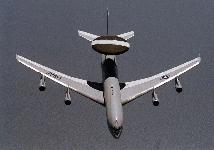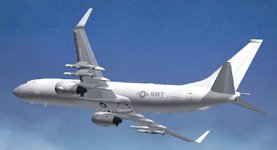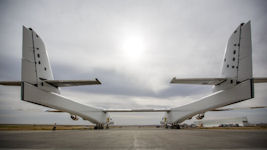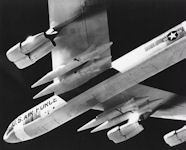Y-20 / Y-XX - Specialized Variants
The Yun-20 can also be used as a platform for "special aircraft" such as early warning aircraft, aerial tankers and large electronic reconnaissance aircraft. The Chinese Air Force's most advanced air police-2000 early warning aircraft still uses the Russian Il-76 as a platform. The successful development of Yun-20 means that China's large-scale early warning aircraft will be 100% domestically produced in the future.
The Y-20 provides Chinese military industry with a homemade platform for domestic production of aerial-tanker, AWACS, large anti-submarine patrol aircraft, and large electronic reconnaissance aircraft. A long-body stretched version of the Chinese Y-20 Military Transport Aircraft is planned, along the lines of the C-141B, to increase the aircraft’s cargo carrying capacity.
It was also rumored that the aircraft might serve as the testbed for the rumored Chinese airborne laser weapon prototype similar to American YAL-1 which is thought to be under development. But the vastly larger Boeing 747 turned out to be undersized for an anti-missile laser, so a Chinese laser-armed airplane might be more like the American Tactical Laser, a C-130 laser gunship.
In the past, due to the lack of large transport aircraft, the Air Force Aviation Corps could only allow fighter jets to reach their destinations individually when they were transferred, and then overhaul and deploy support equipment such as equipment and spare parts through roads and railways. It is easy for the enemy to find fighters that arrive early and can easily increase their combat readiness level; these fighters cannot take off at this time and are easily destroyed by the enemy on the ground. After the Yun-20 is included, it can quickly and simultaneously deliver a variety of support equipment to theater airports, improving the air force's large-scale strategic maneuvering, tactical delivery speed, suddenness, and flexibility to meet the Ministry requirements for team formation and simultaneous deployment of all elements. In addition, Yun-20 can also deliver tanks and armored units, airborne combat units, paratroopers, command vehicles, supplies, etc. It is an ideal tool for large-scale airborne, transportation of materials and equipment, and emergency medical evacuation.
It is conducive to enhancing the early warning and refueling capabilities of the Air Force. The Chinese Air Force's support and support aircraft generally lack large aircraft platforms. For some time to come, Yun-20 will be an inevitable choice for such aircraft platforms. The Yun-20 can serve as an air command center, coordinating fighter and unmanned aircraft operations, so that our army can more effectively direct and guide air operations and avoid "open eyes" during air combat. The Yun-20 can also be used as a platform for "special aircraft" such as early warning aircraft, aerial tankers and large electronic reconnaissance aircraft. After serving in the future in -20, China's large-scale early warning aircraft platform will also be localized. In addition, if the Yun-20 is converted into an aerial tanker, it will significantly increase the continuous combat time and maneuverability of the Air Force, ensuring that various aircraft can jointly complete long-range deployment and long-range operations of large formations. If the Yun-20 is used as a platform for anti-submarine patrol aircraft and electronic reconnaissance aircraft, it will also further expand the cruising range of China's air and sea forces.
| Y-20 Variant | mission | US Counterpart |
|---|---|---|
Cargo Stretch ["C-141B"] | ||
 Y-20B Stretch + Up-engine | The American C-141B was a stretched C-141A with in-flight refueling capability. Stretching of the Starlifter consisted of lengthening the plane 23 feet, 4 inches, which increased cargo capacity by about one-third - 2,171 extra cubic feet (65.13 extra cubic meters). Lengthening of the aircraft had the same effect as increasing the number of aircraft by 30 percent. Wihin a few years the WS-18 low-by-pass engines [the Chinese version of the Russian Soloviev D-30KU], each with a power of 21,000 pounds of thrust will be replaced by the highly fuel efficient CFM LEAP-X high-bypass engine with a power of about 30,000 pounds of thrust |  C-141B Starlifter |
Aerial Refueling | ||
 Y-20U | The combination of long distances and the high vulnerability of forward air bases will require that most forward air defense (and strike) assets operate from bases further back in wartime. This, in turn, will create a high demand for aerial refueling capacities in order to keep sufficient aircraft on station. |  KC-46 Pegasus Tanker |
AEW | ||
 KJ-3000 Y-20 | Airborne Early Warning [AEW] is the detection of enemy air or surface units by radar or other equipment carried in an airborne vehicle, and the transmitting of a warning to friendly units. Airborne early warning and control [AEW & C] is air surveillance and control provided by airborne early warning aircraft which are equipped with search and height-finding radar and communications equipment for controlling weapon systems. |
 E-3 Sentry (AWACS) |
Maritime Patrol | ||
 | The US Navy's P-8A Poseidon is designed to secure the Navy’s future in long-range maritime patrol capability, while transforming how the Navy’s maritime patrol and reconnaissance force will man, train, operate and deploy. The P-8A will provide more combat capability from a smaller force and less infrastructure while focusing on worldwide responsiveness and interoperability with traditional manned forces and evolving unmanned sensors. |  P-8 Multimission Maritime Aircraft (MMA) |
Radar Ground Surveillance | ||
 | The Joint Surveillance Target Attack Radar System (Joint STARS) is a long-range, air-to-ground surveillance system designed to locate, classify and track ground targets in all weather conditions. While flying in friendly airspace, the joint Army-Air Force program can look deep behind hostile borders to detect and track ground movements in both forward and rear areas. |  E-8 Joint STARS / JSTARS |
Electronic Reconnaissance | ||
 | Electronic Reconnaisance aircraft providd indications about the location and intentions of enemyforces and warnings of threatening activity. They broadcast a variety of direct voice communications. Of highest priority are combat advisory broadcasts and imminent threat warnings that can be sent direct to aircraft in danger. They operating both data and voice links to provide target info to US ground based air defenses |  RC-135V/W RIVET JOINT |
Airborne Laser | ||
 | A Tactical Laser can provide powerful capabilities for both lethal and non-lethal ultra-precision engagement of threats with little or no collateral damage. This is often critical in urban environments and congested chokepoints that are vulnerable to terrorist activities or insurgent operations. Operated from a ground, sea or airborne platform, ATL offers the ability to place a precisely calibrated energy pulse on a target from either close in or from a standoff distance of several miles. |  Advanced Tactical Laser (ATL) |
Air-Launched Space Booster | ||
 | Li Tongyu, director of the Aerospace Department of the China Academy of Launch Vehicle Technology, revealed that the academy is developing a rocket that uses solid fuel and can send 100 kilograms of payload into low-Earth orbit. This new rocket will be launched by China's Y-20 large strategic transport aircraft. Minister Li said: "The Y-20 will carry the rocket and launch it at a specific angle. The rocket will be ignited after leaving the fuselage." From a technical point of view, air-launched carrier rockets and air-launched ballistic missiles are very similar. If you get one, you get the other. |  Stratolaunch |
Air-Launched Ballistic Missiles | ||
 | There is also a view that the Y-20 may become a launch platform for air-launched ballistic missiles. The principle of air-launched ballistic missiles is to use large cargo aircraft, military transport aircraft, and strategic bombers to carry missiles to high altitudes and then release them. After the missiles have achieved the correct posture, the engine ignites, and then they strike at distant targets under the guidance of the guidance system. During the Cold War, both the United States and the Soviet Union secretly developed air-launched ballistic missiles. If the Y-20 is combined with air-launched ballistic missiles, China's nuclear deterrence capability will reach a new level. First, the range of air-launched ballistic missiles and the range of the Y-20 will be superimposed, which will make the strike distance longer. Secondly, in wartime, it is difficult for the enemy to distinguish which of the large aircraft with basically the same appearance are carrying ballistic missiles and which are carrying ordinary ammunition or supplies; even if the enemy can distinguish them, as long as the transmitter is flying over the mainland, it will be covered by its own ground/sea surface air defense forces, and it will be difficult for the enemy to shoot it down by conventional means, and the concealment and survivability of the transmitter will be higher. Moreover, in theory, as long as the carrier aircraft takes off, all positions within the airspace it can reach can be used as launch points, which is extremely flexible in combat. At the same time, if air-launched ballistic missiles use conventional warheads, they can effectively enhance China's "anti-access/area denial" capabilities, allowing China's anti-aircraft carrier killer to break away from the single land-based launch mode, making the opponent more difficult to defend against.
|  GAM-87 Skybolt |
|
NEWSLETTER
|
| Join the GlobalSecurity.org mailing list |
|
|
|

